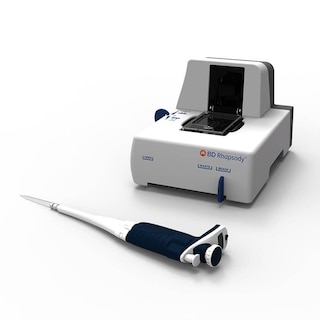-
Your selected country is
Middle East / Africa
- Change country/language
Old Browser
This page has been recently translated and is available in French now.
Looks like you're visiting us from {countryName}.
Would you like to stay on the current country site or be switched to your country?


Oligo Rat Anti-Mouse CD134
Regulatory Status Legend
Any use of products other than the permitted use without the express written authorization of Becton, Dickinson and Company is strictly prohibited.
Preparation And Storage
Recommended Assay Procedures
Put all BD® AbSeq Reagents to be pooled into a Latch Rack for 500 µL Tubes (Thermo Fisher Scientific Cat. No. 4900). Arrange the tubes so that they can be easily uncapped and re-capped with an 8-Channel Screw Cap Tube Capper (Thermo Fisher Scientific Cat. No. 4105MAT) and the reagents aliquoted with a multi-channel pipette.
BD® AbSeq tubes should be centrifuged for ≥ 30 seconds at 400 × g to ensure removal of any content in the cap/tube threads prior to the first opening.
Product Notices
- This reagent has been pre-diluted for use at the recommended volume per test. Typical use is 2 µl for 1 × 10^6 cells in a 200-µl staining reaction.
- Source of all serum proteins is from USDA inspected abattoirs located in the United States.
- Caution: Sodium azide yields highly toxic hydrazoic acid under acidic conditions. Dilute azide compounds in running water before discarding to avoid accumulation of potentially explosive deposits in plumbing.
- The production process underwent stringent testing and validation to assure that it generates a high-quality conjugate with consistent performance and specific binding activity. However, verification testing has not been performed on all conjugate lots.
- Illumina is a trademark of Illumina, Inc.
- Please refer to http://regdocs.bd.com to access safety data sheets (SDS).
- Please refer to bd.com/genomics-resources for technical protocols.
- For U.S. patents that may apply, see bd.com/patents.
Companion Products






The OX-86 monoclonal antibody specifically binds to the OX-40 antigen (CD134), also known as OX-40L receptor. CD134 is a 50-kDa type-I membrane glycoprotein that belongs to the NGFR/TNFR superfamily. Mouse CD134 is expressed on activated CD4+ and CD8+ T lymphocytes and has been shown to be the sole receptor for the OX-40 Ligand (OX-40L). In the brains of mice with actively induced experimental allergic encephalomyelitis, the expression of CD134 on CD4+ T lymphocytes correlates with disease progression. The OX-40/OX-40L system supplies a costimulatory signal for T-cell proliferation and B-cell proliferation and differentiation. In addition, OX-40 antigen provides a costimulatory signal that induces T cells to proliferate in a CD28-independent manner. In the intact animal, CD134 does not appear to be essential for many T-cell responses, but it seems to play a major role in the pathogenesis of some autoimmune diseases. The OX-86 mAb stains both CD4+ and CD8+ activated T cells, and this expression pattern has been confirmed using OX-40L-Ig fusion protein. CD134 was also detected, using OX-86 mAb, on B cells after stimulation with anti-IgM plus anti-CD40 mAb HM40-3 (Cat. no. 553721). OX-86 mAb does not block binding of OX-40L to OX-40, and it stimulates T-cell proliferation mildly.
Development References (8)
-
Akiba H, Oshima H, Takeda K, et al. CD28-independent costimulation of T cells by OX40 ligand and CD70 on activated B cells. J Immunol. 1999; 162(12):7058-7066. (Biology). View Reference
-
Baum PR, Gayle RB 3rd, Ramsdell F, et al. Molecular characterization of murine and human OX40/OX40 ligand systems: identification of a human OX40 ligand as the HTLV-1-regulated protein gp34. EMBO J. 1994; 13(17):3992-4001. (Biology). View Reference
-
Higgins LM, McDonald SA, Whittle N, Crockett N, Shields JG, MacDonald TT. Regulation of T cell activation in vitro and in vivo by targeting the OX40-OX40 ligand interaction: amelioration of ongoing inflammatory bowel disease with an OX40-IgG fusion protein, but not with an OX40 ligand-IgG fusion protein. J Immunol. 1999; 162(1):486-493. (Clone-specific: Western blot). View Reference
-
Pippig SD, Pena-Rossi C, Long J, et al. Robust B cell immunity but impaired T cell proliferation in the absence of CD134 (OX40). J Immunol. 1999; 163(12):6520-6529. (Biology). View Reference
-
Stuber E, Neurath M, Calderhead D, Fell HP, Strober W. Cross-linking of OX40 ligand, a member of the TNF/NGF cytokine family, induces proliferation and differentiation in murine splenic B cells. Immunity. 1995; 2(5):507-521. (Biology). View Reference
-
Weinberg AD, Vella AT, Croft M. OX-40: life beyond the effector T cell stage. Semin Immunol. 1998; 10(6):471-480. (Biology). View Reference
-
Weinberg AD, Wegmann KW, Funatake C, Whitham RH. Blocking OX-40/OX-40 ligand interaction in vitro and in vivo leads to decreased T cell function and amelioration of experimental allergic encephalomyelitis. J Immunol. 1999; 162(3):1818-1826. (Biology). View Reference
-
al-Shamkhani A, Birkeland ML, Puklavec M, Brown MH, James W, Barclay AN. OX40 is differentially expressed on activated rat and mouse T cells and is the sole receptor for the OX40 ligand. Eur J Immunol. 1996; 26(8):1695-1699. (Immunogen). View Reference
Please refer to Support Documents for Quality Certificates
Global - Refer to manufacturer's instructions for use and related User Manuals and Technical data sheets before using this products as described
Comparisons, where applicable, are made against older BD Technology, manual methods or are general performance claims. Comparisons are not made against non-BD technologies, unless otherwise noted.
For Research Use Only. Not for use in diagnostic or therapeutic procedures.
Report a Site Issue
This form is intended to help us improve our website experience. For other support, please visit our Contact Us page.